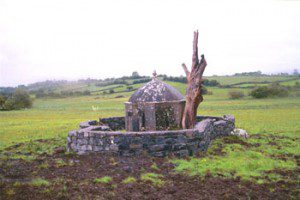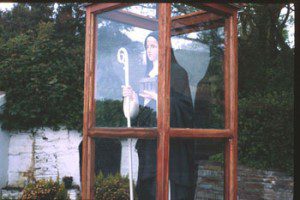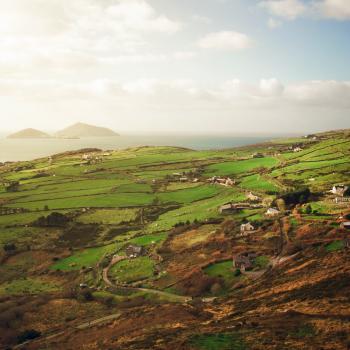
In my last post I made several references to Holy Wells as thin places. From the Chalice Well in western England, to Tobernault in northwest Ireland, to countless wells throughout the Celtic lands dedicated to St. Brigid or other much loved saints — Holy Wells (water sources that serve as places of prayer and veneration) are icons of the Celtic spirit.
There is no “standard” Holy Well — they come in many forms. Some are wells are in the traditional sense, complete with round walls surrounding them and a bucket with a rope. But many others feature different kinds of water sources. Many are springs, or even waterfalls that emerge from underground, and I’ve even seen one that is merely a crevice in a rock where rain water stands. What they all share in common — and what separates them from ordinary or mundane water sources — is their sacred function as places where people go to pray, to worship, to intercede, and to seek healing. Some Holy Wells are legendary for their healing properties; many have particular reputations: one is renowned for healing headaches, while another one nearby might be known for curing toothaches. Especially in lands with large Catholic populations like most of Ireland, many wells are dedicated to a saint, often a local holy man or woman who may not even be recognized as a canonized saint by the church at large. Of course, a good portion of wells have a particular association with saints of renown, especially St. Mary and St. Brigid. I don’t know if anyone has done a particular study on Holy Wells, but my sense is that far more are dedicated to women saints than to men — but “men’s” wells do exist.

People come to Holy Wells for the water of course, treating it with the same respect that any Catholic would treat water from a shrine like Lourdes. Some Holy Wells even feature cups with signs encouraging visitors to take a drink. But there’s more to your average Holy Well than just the water it yields. Often wells have “patterns” associated with them: formal procedures for praying at the well, usually involving the Rosary or other formal prayers and a particular route to walk while praying (for example, moving clockwise around the well 9 times). Some wells even have signs that instruct the first-time visitor how to properly follow the pattern at the well.
Many “accessories” to holy wells can be found at various sites. Some have human-made adornments: statues, gardens, walls, crosses, huts or shelters, all meant to give the well a sense of spiritual reverence as well as a feeling of being well cared-for; indeed, many holy wells are located in beautifully tended grounds that function as a small park. Many wells are accompanied by a tree that has come to be venerated alongside the well; some of these trees are covered with clooties, small rags or strips of cloth that have been tied to the tree as a type of prayer remembrance. The legend of the clooties holds that they “carry” the prayers of the person who first tied them to the tree; as the clootie is slowly broken down by the elements over time, the prayers are “released” — almost like a time-released pill.
I must confess to feeling some ambivalence about clooties myself. While they clearly represent an ancient folk custom and are inspiring for the prayer and devotion they represent, on the other hand a tree covered by clooties could be hurt or even killed by all the tightly knotted strips of cloth. I’m not sure that God — or, for that matter, the ancient Celtic saints — truly want prayers when they are expressed at the expense of an innocent tree!

Something else often found at holy wells: coins. Traditionally, the coins would have been tossed into the well, a custom that very likely has pre-Christian roots. Archaeology has shown that the ancient Celts would make offerings to their pagan gods by sacrificing valuable metal items to bodies of water — entire hoards of votive offerings have been excavated from rivers, including swords, torques, shields, and other items fashioned from metals like silver or bronze or even gold. Although some of these items are clearly valuable from their composition of precious metals, scholars suspect that the armaments offered as sacrifices to the rivers were actually made for ritual purposes (a shield made of silver or gold likely was too valuable and not practical enough for use in a real battle). The ritual sacrifice of votive offerings leaves us with more questions than answers, but it suggests that the pre-Christian Celts saw water sources as sacred, and perhaps even as portals to the “otherworld” — the realm the gods and the ancestors. By making offerings, the ancients were giving gifts to their spiritual allies, hoping in turn for blessings, a fruitful harvest, or triumph in battle.
It’s easy to see how the folk practice of tossing a coin into a wishing well is a vestige of the ancient forms of sacrifice. This has even extended to fountains (the next time you visit a shopping mall or an airport, stop and look at the fountains — they will likely contain hundreds of pennies and nickels and other coins, tossed in by passersby who were making a wish or simply re-enacting an ancient practice (or, making a donation, since the owners of many fountains now designate their “take” to a worthy cause). Some Holy Wells even have coin boxes installed next to the water source — which may make good ecological sense, since throwing the coins into the well could compromise the quality of the water.

Other wells, for example St. Brigid’s Well near Liscannor in County Clare, Ireland, are renowned for various other “sacrificial” objects left at the well: candles, rosaries, holy cards, or for that matter dolls, pictures of loved ones, or even a pair of crutches. These “votive offerings” symbolize the prayers of the persons who visited the well.
One time I was leading a small group of American pilgrims through Ireland, and we stopped to pray at one of the Holy Wells near Kildare. While we were there, a local family came by to offer their own prayers, and one member of our group struck up a conversation with them. They were actually there to offer thanks — they had been praying at the well for their mother, who had been diagnosed with cancer, and they had recently received the good news that the cancer was in remission. So of course they returned to the place of their intercession to offer a new prayer of gratitude.
I suppose some people might look at the folk practices associated with Holy Wells — tying ribbons to trees, executing precise actions while praying, treating the water with special reverence — and dismiss it all as only so much superstition. But I want to make the case for looking at Holy Wells not with the cold eyes of scientific skepticism, but rather the compassionate eyes that see value in tradition and myth and wonder.
Prayer is not magic, and traditional practices associated with prayer — like visiting a sacred water source — do not imbue the prayer with any more “power” than any other type of prayer might contain. So why go to all the fuss, of visiting a well, or following the pattern, or treating the water with reverence? To answer that question I think we have to go back to the idea of the Thin Place. Some places have a special ability to bring us face to face with the mystery of eternity. That mystery is always present in our lives! But we do not always pay attention to it.

So we go to visit a place traditionally regarded as sacred, like a Holy Well, to help us pay attention. We perform the rituals associated with such a place: drinking the water, following the pattern, leaving a coin or some other votive object to symbolize our prayer, to help us pay attention. By joining in to long-standing folk customs associated with Holy Wells, we are joining in with people from generation after generation who have found comfort and inspiration by coming to these special places to pray and to praise.
So are Holy Wells “Celtic”? Not in any strict sense — the veneration of water sources can be found in many cultures around the world. But I think it’s no accident that Holy Wells are so visible in the Celtic lands. They are icons of the Celtic spirit, which means that I see in Holy Wells the gifts of Celtic wisdom: a recognition of God’s presence in nature and the ordinary stuff of life, the importance of regular prayer, a sense that spirituality is not something reserved just for Church or Sundays, but is intimately a part of everyday life. And since many Holy Wells do have associations with Celtic saints like Brigid or Patrick or Cuthbert, the Wells reinforce the sense of communion and connection that living spiritual seekers today can find with the great Celtic saints of old.
Enjoy reading this blog?
Click here to become a patron.
Stay in touch! Connect with Carl McColman on Facebook:














